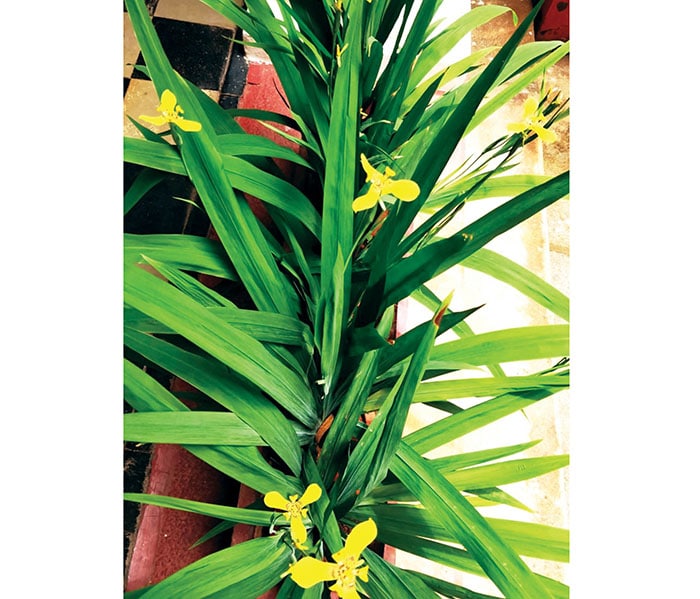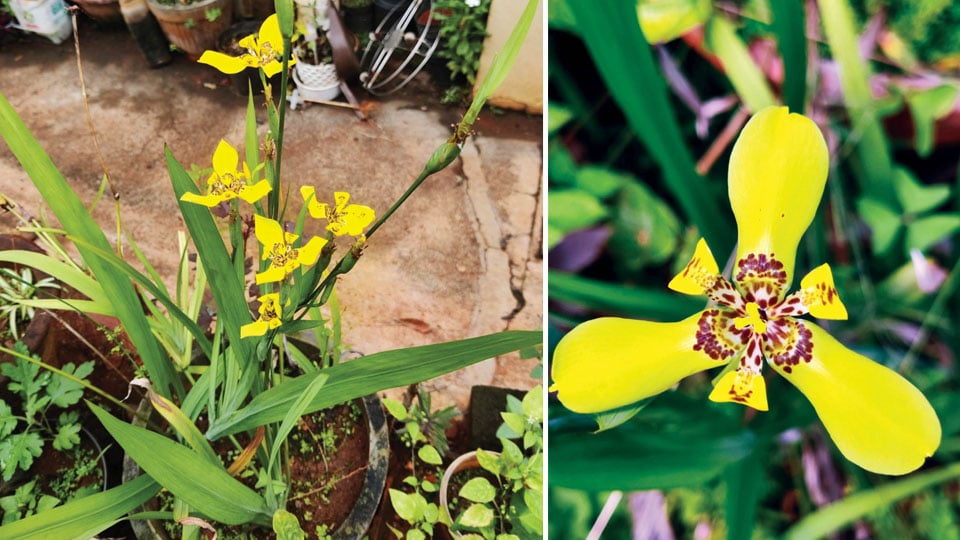Text & photographs by Dr. Mahadeswara Swamy, Scientist
Iris is a general term for more than 250 species of flowering plants. A few among them are called Walking Irises. The name implies the plants walk. In fact they get the name from the propagation method. When the flowers fade plantlets (baby plants) develop on extended stems and become heavy as they grow older only to be pushed down to the ground. Then they root into the soil and grow as independent plants. The domino effect follows resulting in more adjoining area being colonised. This is how the Walking Iris plants “walk” through the landscape. Yellow Walking Iris is one such plant with flamboyant flowers. The plant is commonly called ‘Apostle Plant’ referring to 12 apostles, as some believe the plant needs twelve leaves before it blooms. It is also known as ‘Fan Iris’, ‘Poor man’s Orchid’ besides ‘Martinique trimezia’. It is also called “Hand of God” because of three flower petals. The scientific name is Trimezia steyermarkii (syn. Neomarica longifolia) belonging to Iridaceae family. Genus epithet ‘Trimezia’ is derived from Greek words ‘tri’ and ‘meze’, which mean ‘three’ and ‘greater’ respectively, a reference to the distinctive flowers, whose 3 outer segments are bigger than the inner ones. Species epithet ‘steyermarkii’ is in honour of American Botanist Julian Steyermark. Widely cultivated in the tropics and subtropics, the plant is native to warmer parts of Central and South America and West Indies.
Trimezia steyermarkii is a rhizomatous evergreen or seasonal perennial growing upto 1 meter. The rhizomes (underground stems) are erect, 2-5 cm long and 2-3 cm wide, with persistent leaf bases, which are usually fibrous. The leaves are lance or sword shaped (ensiform leaves); thin textured with a prominent mid-rib closely resembling those of the genus Iris. Flowering stems are slightly shorter than the leaves, round, usually with few branches and herbaceous spathes (sheathing bracts); occasionally simple. The plant sports yellow coloured flowers; tepals (petals) 6, outer 3 spreading almost horizontally and the remaining 3 curled inner, arching forward and then recurved (geniculate). A cluster of elaiophores (glands) near the base add a pop of texture to the basal central portion of the bloom. The petals are embellished with brownish-purple bands/ spots (mahogany markings) at their base resembling tiger stripes which make the flowers look glitzy. Stamens 3, distinct or connate; Ovary inferior, carpels 3, tri-locular with axile placentation & 3-branched style; The fruit is a loculicidal capsule. Though the plants bloom over a long period, the individual flowers are short lived (only for a day).

Useful tips
- A lovely exotic plant with upright foliage looks dazzling even when not in flowering. A valuable addition to any garden to enhance year-round charm.
- It is a hardy species that grows easily with minimum care. Suitable for mass planting in floral beds in semi shade areas of the garden especially under trees. Also suited for container gardening and hanging baskets where it’s arching stems are the highlight. It is reported to be suitable for use as a bog plant at edges of the ponds and other water bodies.
- Prefers semi shade, though it can be grown under full sun in places with mild sunlight. Shade or semi-shade areas receiving sunlight during morning are most suitable. If planted in completely shaded areas, the flowering is reduced or nil.
- Plants can tolerate a range of soil types. Nevertheless, well-drained quality potting soil (normal potting mixture) is desirable.
- Water moderately to keep the soil moist though they can resist drought quite well.
- Cut back the flowering stalks after flowering but leave the foliage intact to synthesise and store essential nutrients for the subsequent season.
- Trim the leaves at ground level after they turn yellow… This will help reduce the possibility of winter diseases or pests attack (snails and slugs).
- In Mysuru, the peak season is mid September to mid December, though they are reported to bloom throughout the year in their nativity.

Propagation
They can be easily propagated using plantlets produced on the flower stems or by division of rhizomes. Separate plantlets and plant them in a desired place. When propagated using rhizomes, plant them in such a way that they are slightly visible on the soil surface or thinly covered. Water the plants daily.
My observation
The buds open immediately after 9 am (between 9 and 9.30 am). Experience the magical unfolding of the petals, a visual treat!
Mob: 97429-91057 e-mail: [email protected]








Recent Comments